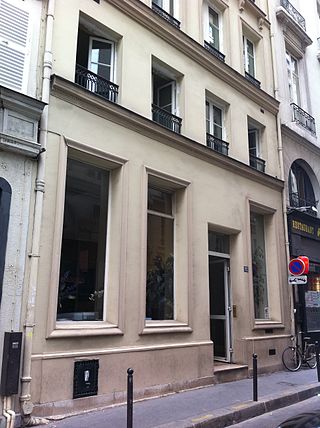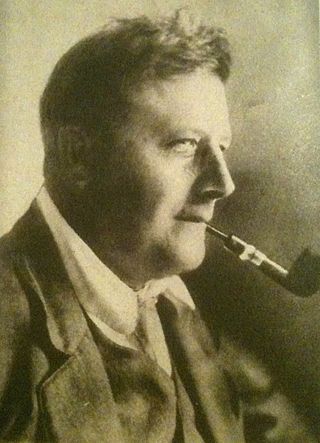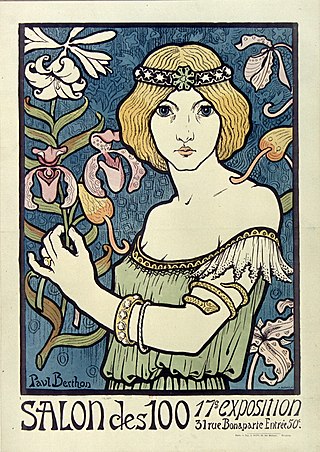
Comte Henri Marie Raymond de Toulouse-Lautrec-Monfa, known as Toulouse-Lautrec, was a French painter, printmaker, draughtsman, caricaturist, and illustrator whose immersion in the colourful and theatrical life of Paris in the late 19th century allowed him to produce a collection of enticing, elegant, and provocative images of the sometimes decadent affairs of those times.

The Nabis were a group of young French artists active in Paris from 1888 until 1900, who played a large part in the transition from Impressionism and academic art to abstract art, symbolism and the other early movements of modernism. The members included Pierre Bonnard, Maurice Denis, Paul Ranson, Édouard Vuillard, Ker-Xavier Roussel, Félix Vallotton, Paul Sérusier and Auguste Cazalis. Most were students at the Académie Julian in Paris in the late 1880s. The artists shared a common admiration for Paul Gauguin and Paul Cézanne and a determination to renew the art of painting, but varied greatly in their individual styles. They believed that a work of art was not a depiction of nature, but a synthesis of metaphors and symbols created by the artist. In 1900, the artists held their final exhibition and went their separate ways.

Pierre Bonnard was a French painter, illustrator and printmaker, known especially for the stylized decorative qualities of his paintings and his bold use of color. A founding member of the Post-Impressionist group of avant-garde painters Les Nabis, his early work was strongly influenced by the work of Paul Gauguin, as well as the prints of Hokusai and other Japanese artists. Bonnard was a leading figure in the transition from Impressionism to Modernism. He painted landscapes, urban scenes, portraits and intimate domestic scenes, where the backgrounds, colors and painting style usually took precedence over the subject.
Louis Auguste Mathieu Legrand was a French artist, known especially for his aquatint engravings, which were sometimes erotic. He was awarded the Légion d'honneur for his work in 1906.

Maxime-Pierre Jules Dethomas was a French painter, draughtsman, printmaker, illustrator, and was among the best known theater-set and costume designers of his era. As an artist, Dethomas was highly regarded by his contemporaries and exhibited widely, both within France and abroad. He was a regular contributor to the Impressionistes et Symbolistes, and a founding committee member of the Salon d'Automne. In 1912, he was awarded the Chevalier de la Légion d'honneur for his contributions to French art.

Le Chabanais was one of the best known and most luxurious brothels in Paris, operating near the Louvre at 12 rue Chabanais from 1878 until 1946, when brothels were outlawed in France. It was founded by the Irish-born Madame Kelly, who was closely acquainted with several members at the Jockey-Club de Paris. Among the habitués were Albert, Prince of Wales ; Henri de Toulouse-Lautrec; Cary Grant; Humphrey Bogart, Mae West and diplomatic guests of the French government.

Henri-Gabriel Ibels (1867–1936) was a French illustrator, printmaker, painter and author.

Salon des Cent was a commercial art exhibition in Paris, based at 31 Rue Bonaparte. The Salon sold color posters, prints and reproductions of artwork to the general public at reasonable prices. It was established in February 1894 by Léon Deschamps, founder of La Plume an avant garde literary and artistic magazine. It became known for its exhibitions showcasing the works of contemporary graphical artists. The salon held exhibitions until 1900. Many of the posters advertising Salon des Cent exhibitions have themselves become collectors' items.
Fernand-Louis Gottlob was a French graphic artist whose caricatures appeared in many humorous magazines.

Gustave Pellet (1859–1919) was a French publisher of art. He is best known for publishing prints of erotic artworks by Henri de Toulouse-Lautrec and Louis Legrand.

Cha-U-Kao was a French entertainer who performed at the Moulin Rouge and the Nouveau Cirque in the 1890s. Her stage name was also the name of a boisterous popular dance, similar to the can-can, which came from the French words "chahut", meaning "noise" and "chaos". She was depicted in a series of paintings by Henri de Toulouse-Lautrec. Cha-U-Kao soon became one of his favorite models. The artist was fascinated by this woman who dared to choose the classic male profession of clowning and was not afraid to openly declare that she was a lesbian.

La Fleur blanche was a famous maison close (brothel) in the city of Paris, located at 6 rue des Moulins in the 1st Arrondissement. The property was also known as rue des Moulins and was famous for its torture room.

Désiré Dihau was a French bassoonist and composer. He was the bassoonist painted by Edgar Degas in The Orchestra at the Opera with the cellist Louis-Marie Pilet seated behind him.
Prostitution in Impressionist painting was a common subject in the art of the period. Prostitution was a very widespread phenomenon in nineteenth-century Paris and although an accepted practice among the nineteenth century bourgeoisie, it was nevertheless a topic that remained largely taboo in polite society. As a result, Impressionist works depicting the prostitute often became the subject of scandal, and particularly venomous criticism. Some works showed her with considerable sympathy, while others attempted to impart an agency to her; likewise some work showed high-class courtesans, and others prostitutes awaiting clients on the streets. In addition to the sexual revulsion/attraction the figure of the prostitute stirred, she functioned as a sign of modernity, a clear sign of the entanglement of sex, class, power and money.

Le Lit is a painting by Henri de Toulouse-Lautrec from around 1892 which depicts two women sharing a bed. The painting has been held by public collections in France since 1937, and by the Musée d'Orsay in Paris since 1986.

L'Estampe originale was a French periodical publishing portfolios of original prints in a limited edition of 100 for subscribers. It produced nine issues quarterly between 1893 and 1895, containing a total of 95 original prints by a very distinguished group of 74 artists, including Henri de Toulouse-Lautrec, Gauguin, Renoir, Pissarro, Whistler, Paul Signac, Odilon Redon, Rodin, Henri Fantin-Latour, Félix Bracquemond, Félicien Rops and Puvis de Chavannes. Almost all of Les Nabis contributed: Pierre Bonnard, Maurice Denis, Paul Ranson, Édouard Vuillard, Ker-Xavier Roussel, Félix Vallotton, and Paul Sérusier. British artists included William Nicholson, Charles Ricketts, Walter Crane and William Rothenstein; besides Whistler, Joseph Pennell was the only American.

Palmire Louise Dumont, generally known as Madame Palmyre or Palmyre, was the manager and owner of two early gay bars in Paris in the 1890s–1900s: the lesbian bar La Souris and the mixed Palmyr's Bar. She was an iconic figure in creating the culture of "gay Paree" in Montmartre during the Belle Époque.

The Hangover (Suzanne Valadon) (French: Gueule de Bois / La Buveuse), also known as The Drinker, is an oil on canvas painting by French post-Impressionist artist Henri de Toulouse-Lautrec, created from 1887 to 1889, just before he became successful as an artist. The painting depicts a drunken woman drinking alone in a club, reflecting the counterculture of Montmartre and the specter of alcoholism among French women during the Belle Époque. The model in The Hangover is artist Suzanne Valadon, Lautrec's lover. In the early 1880s, after falling from a circus trapeze at the age of 15 and suffering a back injury, Valadon was forced to switch careers and began working as an art model in Montmartre. Although she had been drawing all her life, by 1883, she had become an artist herself, and she would go on to become the first woman painter admitted to the Société Nationale des Beaux-Arts.

Portrait of Toulouse Lautrec, in Villeneuve-sur-Yonne, with the Natansons, sometimes referred to as Toulouse-Lautrec Cooking, is an 1898 painting by French artist Édouard Vuillard. The work depicts fellow artist Henri de Toulouse-Lautrec on holiday cooking in the kitchen at Les Relais, the country home of Vuillard's patron Thadée Natanson in Villeneuve-sur-Yonne. The painting is held by the Musée Toulouse-Lautrec, in Albi.




























